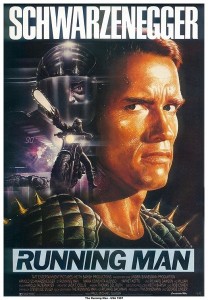 Finding incredible success as a writer, Stephen King wanted to produce multiple works in short order without the fear of burning out his audience. To this end, he adopted the pseudonym of Richard Bachman. In 1982, Bachman would release his fourth book The Running Man about a game show hosted by the government where people could become the prey of hitmen in a dystopian United States for money. By 1985, Bachman would be outed as King and his books from that time would in short order see significant sales growth. Two years later, the book would be loosely adapted into a movie starring Arnold Schwarzenegger. For the film, the US government is an oppressive totalitarian regime that controls the media absolutely amidst a dystopian society. To pacify the people, a game show called the Running Man airs featuring supposed criminals hunted for entertainment claiming those that survive are pardoned for their crimes. Ben Richards, a police officer wrongly convicted of a massacre, manages to escape a labor camp with rebels against the government only for the group to be recaptured and placed on the game show. Hunted by the game’s stalkers, Richards must try to survive while helping the rebels to clear his name and topple the corrupt regime. The film would be a modest success and garnered mixed reactions. Schwarzenegger would claim in 2014 he’s heard rumors of a sequel to Running Man as the actor has been seeing many of his films come back such as in Terminator Genisys (2015) and the upcoming The Legend of Conan and Triplets (a sequel to 1988’s Twins).
Finding incredible success as a writer, Stephen King wanted to produce multiple works in short order without the fear of burning out his audience. To this end, he adopted the pseudonym of Richard Bachman. In 1982, Bachman would release his fourth book The Running Man about a game show hosted by the government where people could become the prey of hitmen in a dystopian United States for money. By 1985, Bachman would be outed as King and his books from that time would in short order see significant sales growth. Two years later, the book would be loosely adapted into a movie starring Arnold Schwarzenegger. For the film, the US government is an oppressive totalitarian regime that controls the media absolutely amidst a dystopian society. To pacify the people, a game show called the Running Man airs featuring supposed criminals hunted for entertainment claiming those that survive are pardoned for their crimes. Ben Richards, a police officer wrongly convicted of a massacre, manages to escape a labor camp with rebels against the government only for the group to be recaptured and placed on the game show. Hunted by the game’s stalkers, Richards must try to survive while helping the rebels to clear his name and topple the corrupt regime. The film would be a modest success and garnered mixed reactions. Schwarzenegger would claim in 2014 he’s heard rumors of a sequel to Running Man as the actor has been seeing many of his films come back such as in Terminator Genisys (2015) and the upcoming The Legend of Conan and Triplets (a sequel to 1988’s Twins).
 Popular works of science fiction are not limited to the United States, as noted previously with Doctor Who. Britain would produce another popular SF series in Red Dwarf in 1988. Writers Rob Grant and Doug Naylor were influenced by the radio sketch comedy series “Dave Hollins: Space Cadet” on the Son of Cliché show which featured the eponymous character in space far from Earth joined by his computer Hab. This concept was evolved into the series Red Dwarf, named for the mining space vessel the show initially took place within, and featured Dave Lister as the last known human in the universe. For the series, a radiation leak wipes out the crew of Red Dwarf save Lister who is safe in suspended animation where he remains for three million years until the ship becomes a livable environment again. This turn of events sees Lister outlive the human race when he’s awakened by the computer Holly and discovers his pregnant cat Frankenstein became the progenitor of an evolved species of feline leading to their modern final humanoid descendant Cat. Concerned with Lister’s mental health considering his isolation, Holly generates a living hologram of Lister’s long dead bunkmate Arnold Rimmer (who coincidentally was responsible for the radiation leak that killed the crew). Lister, Rimmer, Cat, and Holly travel through space encountering all kinds of bizarre phenomenon, joined along the way by the robot Kryten and Kristine Kochanski, Lister’s ex-girlfriend from a parallel universe in which she was the last survivor of Red Dwarf. The series would initially do well only to see its ratings dip. Red Dwarf developed a cult following which eventually grew into ratings over time during its sixth series (1993), finding its greatest heights in the eighth series in 1999. Sadly, the show would go on hiatus around this time due to Rob Grant’s desire to do something different but Red Dwarf returned in 2009 for the three-part Red Dwarf: Back to Earth leading to the tenth series in 2012. An eleventh and twelfth series have been commissioned and will begin airing in 2016. The same year Britain unveiled Red Dwarf to the world, Japan premiered an animated picture in theaters that helped change the prominence of Japanese animation in America.
Popular works of science fiction are not limited to the United States, as noted previously with Doctor Who. Britain would produce another popular SF series in Red Dwarf in 1988. Writers Rob Grant and Doug Naylor were influenced by the radio sketch comedy series “Dave Hollins: Space Cadet” on the Son of Cliché show which featured the eponymous character in space far from Earth joined by his computer Hab. This concept was evolved into the series Red Dwarf, named for the mining space vessel the show initially took place within, and featured Dave Lister as the last known human in the universe. For the series, a radiation leak wipes out the crew of Red Dwarf save Lister who is safe in suspended animation where he remains for three million years until the ship becomes a livable environment again. This turn of events sees Lister outlive the human race when he’s awakened by the computer Holly and discovers his pregnant cat Frankenstein became the progenitor of an evolved species of feline leading to their modern final humanoid descendant Cat. Concerned with Lister’s mental health considering his isolation, Holly generates a living hologram of Lister’s long dead bunkmate Arnold Rimmer (who coincidentally was responsible for the radiation leak that killed the crew). Lister, Rimmer, Cat, and Holly travel through space encountering all kinds of bizarre phenomenon, joined along the way by the robot Kryten and Kristine Kochanski, Lister’s ex-girlfriend from a parallel universe in which she was the last survivor of Red Dwarf. The series would initially do well only to see its ratings dip. Red Dwarf developed a cult following which eventually grew into ratings over time during its sixth series (1993), finding its greatest heights in the eighth series in 1999. Sadly, the show would go on hiatus around this time due to Rob Grant’s desire to do something different but Red Dwarf returned in 2009 for the three-part Red Dwarf: Back to Earth leading to the tenth series in 2012. An eleventh and twelfth series have been commissioned and will begin airing in 2016. The same year Britain unveiled Red Dwarf to the world, Japan premiered an animated picture in theaters that helped change the prominence of Japanese animation in America.
 Mangaka (comic artist) Katsuhiro Otomo sought to usurp the norms of Japanese comics in art and storytelling with a passion for science fiction. He would apply this passion with his unfinished work Fireball in 1979 and continued the following year with Domu (which won Japan’s Science Fiction Grand Prix). It would be his next work, however, that not only raised the industry to another level but heightened awareness of manga and anime around the world including in America. Akira told the story of a world rebuilding itself after World War III as Tokyo was wiped out and Neo-Tokyo was built in its stead in Tokyo Bay. The city is overrun with anti-government rebels and bosozoku (biker tribe) gangs as the story begins with the latter. Shotaro Kaneda’s gang was riding through the ruins of Tokyo when fellow member Tetsuo Shima crosses paths with a child Esper (people who possess psionic abilities) which awakens his own latent powers. Driven progressively unhinged from the encounter, Tetsuo learns Tokyo was destroyed by a child named Akira and seeks to take Akira’s destructive power for himself. Kaneda and Kei, an anti-government terrorist, become embroiled in this conflict between Tetsuo and the military with Akira caught in the middle. The popularity of Akira lead to an animated feature film of the same name in 1988 that underperformed at box office but became a cult film. Akira is considered a landmark in anime, signaling an artistic change in the industry and is considered one of the best animated and science fiction films in movie history. Carl Macek’s Streamline Pictures would bring Akira to America in 1991 (though it was widely available with tape traders before then) while Marvel localized its base manga in print (added color and flipped the art to read left-to-right) which was considered a breakthrough in the American market. While Americans were aware of series like Voltron and Robotech, Akira opened the west up to the barriers being torn down in animation and comics in Japan largely creating the anime subculture in the United States with a hunger for its more mature content. The same year Akira came to Japanese theaters, the American cinema would introduce a new multimedia franchise involving aliens with a penchant for spoiled milk.
Mangaka (comic artist) Katsuhiro Otomo sought to usurp the norms of Japanese comics in art and storytelling with a passion for science fiction. He would apply this passion with his unfinished work Fireball in 1979 and continued the following year with Domu (which won Japan’s Science Fiction Grand Prix). It would be his next work, however, that not only raised the industry to another level but heightened awareness of manga and anime around the world including in America. Akira told the story of a world rebuilding itself after World War III as Tokyo was wiped out and Neo-Tokyo was built in its stead in Tokyo Bay. The city is overrun with anti-government rebels and bosozoku (biker tribe) gangs as the story begins with the latter. Shotaro Kaneda’s gang was riding through the ruins of Tokyo when fellow member Tetsuo Shima crosses paths with a child Esper (people who possess psionic abilities) which awakens his own latent powers. Driven progressively unhinged from the encounter, Tetsuo learns Tokyo was destroyed by a child named Akira and seeks to take Akira’s destructive power for himself. Kaneda and Kei, an anti-government terrorist, become embroiled in this conflict between Tetsuo and the military with Akira caught in the middle. The popularity of Akira lead to an animated feature film of the same name in 1988 that underperformed at box office but became a cult film. Akira is considered a landmark in anime, signaling an artistic change in the industry and is considered one of the best animated and science fiction films in movie history. Carl Macek’s Streamline Pictures would bring Akira to America in 1991 (though it was widely available with tape traders before then) while Marvel localized its base manga in print (added color and flipped the art to read left-to-right) which was considered a breakthrough in the American market. While Americans were aware of series like Voltron and Robotech, Akira opened the west up to the barriers being torn down in animation and comics in Japan largely creating the anime subculture in the United States with a hunger for its more mature content. The same year Akira came to Japanese theaters, the American cinema would introduce a new multimedia franchise involving aliens with a penchant for spoiled milk.
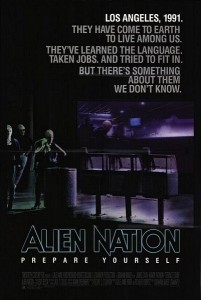 Screenwriter Rockne S. O’Bannon tried to break into Hollywood when he submitted a script to the 1981 television series Darkroom only for the show to be canceled before it was read. Subsequently, similarly themed series Twilight Zone and Amazing Stories emerged where O’Bannon submitted his script to both eventually leading to his working on the former series. Unfortunately, Twilight Zone would essentially be canceled during its second season (a third was made but with an entirely different crew for the sake of syndication) and O’Bannon would develop a script for a science fiction film called Alien Nation. Therein, a slave race of aliens referred as the Newcomers emerge on Earth where they are given asylum and offered freedom for the first time in their lives. The emergence of this race generates a sense of xenophobia amongst humanity as the Newcomers are treated as second-class citizens. An underground drug ring emerges in the Newcomers’ ghetto forcing human police officer Matthew Sykes (played by James Caan) to team up with a Newcomer officer named Sam Francisco (portrayed by Mandy Patinkin) in order to get to the bottom of it. 20th Century Fox producer Gale Anne Hurd would come across the script and was intrigued by its approach to immigration through use of SF and secured its film rights. The film would have moderate success at box office but developed a cult following resulting in a television series, series of TV movies, and published as comic books and novels. It was announced in 2015 a remake is in development. A few weeks after Alien Nation hit theaters, a unique form of cinema emerged in theaters starring pop star Michael Jackson.
Screenwriter Rockne S. O’Bannon tried to break into Hollywood when he submitted a script to the 1981 television series Darkroom only for the show to be canceled before it was read. Subsequently, similarly themed series Twilight Zone and Amazing Stories emerged where O’Bannon submitted his script to both eventually leading to his working on the former series. Unfortunately, Twilight Zone would essentially be canceled during its second season (a third was made but with an entirely different crew for the sake of syndication) and O’Bannon would develop a script for a science fiction film called Alien Nation. Therein, a slave race of aliens referred as the Newcomers emerge on Earth where they are given asylum and offered freedom for the first time in their lives. The emergence of this race generates a sense of xenophobia amongst humanity as the Newcomers are treated as second-class citizens. An underground drug ring emerges in the Newcomers’ ghetto forcing human police officer Matthew Sykes (played by James Caan) to team up with a Newcomer officer named Sam Francisco (portrayed by Mandy Patinkin) in order to get to the bottom of it. 20th Century Fox producer Gale Anne Hurd would come across the script and was intrigued by its approach to immigration through use of SF and secured its film rights. The film would have moderate success at box office but developed a cult following resulting in a television series, series of TV movies, and published as comic books and novels. It was announced in 2015 a remake is in development. A few weeks after Alien Nation hit theaters, a unique form of cinema emerged in theaters starring pop star Michael Jackson.
 Noted in part five of “The ’80s – Geek Edition,” Michael Jackson redefined himself as the King of Pop creating arguably the greatest music video in history with Thriller directed by John Landis. In the Fall of 1988, Jackson tried to take this to another level. Moonwalker was an anthology film starring Michael Jackson largely featuring music from his 1987 album Bad made into a series of music videos loosely associated to each other. The main segment of the film would be “Smooth Criminal” which featured three homeless kids and Jackson stumbling upon the operation of Mr. Big (portrayed by Joe Pesci), a drug kingpin who wants to get the world addicted to his drugs. When the quartet is discovered, Mr. Big sends his soldiers to eliminate them. However, Jackson has a “lucky star” which seemingly is able to be used to transform himself into a variety of things including a sports car, robot, and spaceship. While receiving mixed reviews, Moonwalker was a hit at box office. While reaching the home video market on VHS and LD, it’s unlikely it will ever be released in America on DVD or Blu-ray due to the disparity in film and music rights. A video game and comic book based on the picture would be released, the former developing a cult following status and latter blamed for the demise of Blackthorne Publishing due to its high licensing fee. A month after Moonwalker hit theaters, a popular television series featuring comical robots premiered on a local TV station in Minneapolis, Minnesota.
Noted in part five of “The ’80s – Geek Edition,” Michael Jackson redefined himself as the King of Pop creating arguably the greatest music video in history with Thriller directed by John Landis. In the Fall of 1988, Jackson tried to take this to another level. Moonwalker was an anthology film starring Michael Jackson largely featuring music from his 1987 album Bad made into a series of music videos loosely associated to each other. The main segment of the film would be “Smooth Criminal” which featured three homeless kids and Jackson stumbling upon the operation of Mr. Big (portrayed by Joe Pesci), a drug kingpin who wants to get the world addicted to his drugs. When the quartet is discovered, Mr. Big sends his soldiers to eliminate them. However, Jackson has a “lucky star” which seemingly is able to be used to transform himself into a variety of things including a sports car, robot, and spaceship. While receiving mixed reviews, Moonwalker was a hit at box office. While reaching the home video market on VHS and LD, it’s unlikely it will ever be released in America on DVD or Blu-ray due to the disparity in film and music rights. A video game and comic book based on the picture would be released, the former developing a cult following status and latter blamed for the demise of Blackthorne Publishing due to its high licensing fee. A month after Moonwalker hit theaters, a popular television series featuring comical robots premiered on a local TV station in Minneapolis, Minnesota.
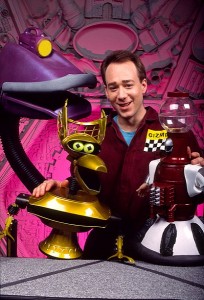 Comedian Joel Hodgson would be inspired by the 1972 science fiction picture Silent Running to create a TV show about a man and his robots watching B-movies in space. Building a set and three robots, Hodgson enlisted the help of some other comedians, a producer, and camera operator to shoot a 30-minute pilot called Mystery Science Theater 3000 that would be picked up by KTMA in Minnesota. Finding success in its initial thirteen episode run in 1988, its series order would be increased only for the station itself to undergo financial woes. Hodgson would cut a “best of” reel of the series and send it to the Comedy Channel where it became of the one first two series it picked up in 1989. Eventually, Comedy Channel would merge with its competitor HA! to form Comedy Central with MST3K made its signature series. Disagreements between Hodgson and producer Jim Mallon would lead to the former leaving the show, replaced by Mike Nelson in its fifth season. After seven seasons and a feature film, Comedy Central would cancel the series only for a write-in campaign from fans to see it return for three seasons on the Sci-Fi Channel. In a manner, the show would return in 2006 when Nelson and subsequently two of his co-stars (Kevin Murphy, who was one of the voices of Tom Servo, and Bill Corbett, who was one of the voices of Crow T. Robot) made RiffTrax, audio commentaries that could be played while watching films in essence to the same effect of what was done with MST3K. The concept proved popular and continues to thrive today. In 2014, Joel Hodgson announced plans to revive the original show culminating in a Kickstarter in 2015 which reached its funding goal in only a week. Three months after MST3K made its premiere on local KTMA, two excellent dudes from San Dimas, California went on an adventure through time.
Comedian Joel Hodgson would be inspired by the 1972 science fiction picture Silent Running to create a TV show about a man and his robots watching B-movies in space. Building a set and three robots, Hodgson enlisted the help of some other comedians, a producer, and camera operator to shoot a 30-minute pilot called Mystery Science Theater 3000 that would be picked up by KTMA in Minnesota. Finding success in its initial thirteen episode run in 1988, its series order would be increased only for the station itself to undergo financial woes. Hodgson would cut a “best of” reel of the series and send it to the Comedy Channel where it became of the one first two series it picked up in 1989. Eventually, Comedy Channel would merge with its competitor HA! to form Comedy Central with MST3K made its signature series. Disagreements between Hodgson and producer Jim Mallon would lead to the former leaving the show, replaced by Mike Nelson in its fifth season. After seven seasons and a feature film, Comedy Central would cancel the series only for a write-in campaign from fans to see it return for three seasons on the Sci-Fi Channel. In a manner, the show would return in 2006 when Nelson and subsequently two of his co-stars (Kevin Murphy, who was one of the voices of Tom Servo, and Bill Corbett, who was one of the voices of Crow T. Robot) made RiffTrax, audio commentaries that could be played while watching films in essence to the same effect of what was done with MST3K. The concept proved popular and continues to thrive today. In 2014, Joel Hodgson announced plans to revive the original show culminating in a Kickstarter in 2015 which reached its funding goal in only a week. Three months after MST3K made its premiere on local KTMA, two excellent dudes from San Dimas, California went on an adventure through time.
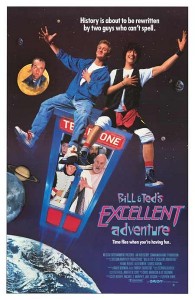 Best friends Ed Solomon and Chris Matheson attended UCLA together where they met and would generate a lot of creative energy with each other. Developing all manner of concepts to ideas, they never had any plans to ever reveal to the world their output in any longstanding manner. Such was the genesis of their idea of Bill and Ted, two teenagers who genuinely enjoyed life’s adventures but were largely oblivious to the world. Born out of an improv workshop, Ed would play Ted and Chris would be Bill and they got such a kick out of the characters they would become them for hours so long as they continued to be amusing. Going their separate ways, they kept in touch over the phone where they developed the idea Bill and Ted would travel back in time to meet history’s most significant figures largely ignorant of their roles in the past and, through their interactions with the past, would be responsible for the world’s greatest mishaps. It wasn’t long before they realized such was too dark for their concept but they were still entertained by the idea of this pair traveling through time. They would develop the character of Rufus, who was a slightly older friend, who happened to have a van that could travel through time making their journeys to the past possible. Writing the script for Bill & Ted’s Excellent Adventure, Chris approached a friend of his father (author Richard Matheson who maybe best known for I Am Legend) who got their foot into Hollywood as several studios reviewed their story. After many several rewrites (including switching out the van, which was considered too much like Back to the Future, for a phone booth coincidentally like Doctor Who‘s TARDIS), it would find a home with De Laurentiis Entertainment Group in 1986 where it was filmed in 1987 only for DEG to go bankrupt before the picture could be released. The following year, it was picked up by Orion Pictures and Nelson Entertainment and finally released to theaters in 1989. Excellent Adventure would be a sleeper hit, making Keanu Reeves (who played Ted Logan) a star and helped comedian George Carlin (who portrayed Rufus) find a new, younger audience. The film would have an animated series the following year, a sequel in theaters the year after that, and a live action TV series a year after that. Another sequel has been in development since 2010. A month after Excellent Adventure hit theaters, a time travel television series of another sort emerged on the air waves.
Best friends Ed Solomon and Chris Matheson attended UCLA together where they met and would generate a lot of creative energy with each other. Developing all manner of concepts to ideas, they never had any plans to ever reveal to the world their output in any longstanding manner. Such was the genesis of their idea of Bill and Ted, two teenagers who genuinely enjoyed life’s adventures but were largely oblivious to the world. Born out of an improv workshop, Ed would play Ted and Chris would be Bill and they got such a kick out of the characters they would become them for hours so long as they continued to be amusing. Going their separate ways, they kept in touch over the phone where they developed the idea Bill and Ted would travel back in time to meet history’s most significant figures largely ignorant of their roles in the past and, through their interactions with the past, would be responsible for the world’s greatest mishaps. It wasn’t long before they realized such was too dark for their concept but they were still entertained by the idea of this pair traveling through time. They would develop the character of Rufus, who was a slightly older friend, who happened to have a van that could travel through time making their journeys to the past possible. Writing the script for Bill & Ted’s Excellent Adventure, Chris approached a friend of his father (author Richard Matheson who maybe best known for I Am Legend) who got their foot into Hollywood as several studios reviewed their story. After many several rewrites (including switching out the van, which was considered too much like Back to the Future, for a phone booth coincidentally like Doctor Who‘s TARDIS), it would find a home with De Laurentiis Entertainment Group in 1986 where it was filmed in 1987 only for DEG to go bankrupt before the picture could be released. The following year, it was picked up by Orion Pictures and Nelson Entertainment and finally released to theaters in 1989. Excellent Adventure would be a sleeper hit, making Keanu Reeves (who played Ted Logan) a star and helped comedian George Carlin (who portrayed Rufus) find a new, younger audience. The film would have an animated series the following year, a sequel in theaters the year after that, and a live action TV series a year after that. Another sequel has been in development since 2010. A month after Excellent Adventure hit theaters, a time travel television series of another sort emerged on the air waves.
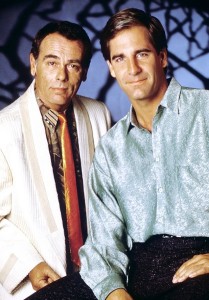 Donald P. Bellisario, along with Glen A. Larson, had developed the sequel series to Battlestar Galactica in Galactica 1980. As noted, a number of issues arose in this venture and, at one time, the new show’s concept would have Apollo’s stepson Troy travel through the past and would be supported in the present by the character Lt. Dillon who would offer information and support. Shooting the pilot in this vein, the concept was abandoned and the show would be firmly set in the present. Almost a decade later, Bellisario would revisit this premise to create Quantum Leap. Wanting to produce an anthology series despite this device becoming unpopular in recent years, Bellisario created his show around Dr. Sam Beckett (played by Scott Bakula), a scientist in the late 20th century trying to develop time travel. However, his work proved unsuccessful and under the threat of his funding being cut, Sam employs his prototype with himself as the test subject. Rather than simply emerging in a different time period, he instead assumed the body of someone in the past and would then leap to someone else in another time when he had corrected some imbalance connected to his host. Guided in this journey by his best friend Al Calavicci (portrayed by Dean Stockwell) as a hologram only Sam and certain others can see and the AI computer Ziggy (voiced by Bellisario’s then-wife Deborah Pratt), Sam must keep leaping until they can find a way to bring him home (drawing some parallels to The Time Tunnel). Despite struggling when it premiered, Quantum Leap became a big hit, winning multiple awards including Emmys, Golden Globes, and Quality TV Awards and ran for five seasons. Coincidentally, Dean Stockwell would go on to play a prominent character in the reboot of Battlestar Galactica. Considered one of the top cult shows of all time, it was revealed in 2010 that a script is being developed for a Quantum Leap feature film by Bellisario. Three months after Quantum Leap premiered on TV, Disney would again bring science fiction to the box office.
Donald P. Bellisario, along with Glen A. Larson, had developed the sequel series to Battlestar Galactica in Galactica 1980. As noted, a number of issues arose in this venture and, at one time, the new show’s concept would have Apollo’s stepson Troy travel through the past and would be supported in the present by the character Lt. Dillon who would offer information and support. Shooting the pilot in this vein, the concept was abandoned and the show would be firmly set in the present. Almost a decade later, Bellisario would revisit this premise to create Quantum Leap. Wanting to produce an anthology series despite this device becoming unpopular in recent years, Bellisario created his show around Dr. Sam Beckett (played by Scott Bakula), a scientist in the late 20th century trying to develop time travel. However, his work proved unsuccessful and under the threat of his funding being cut, Sam employs his prototype with himself as the test subject. Rather than simply emerging in a different time period, he instead assumed the body of someone in the past and would then leap to someone else in another time when he had corrected some imbalance connected to his host. Guided in this journey by his best friend Al Calavicci (portrayed by Dean Stockwell) as a hologram only Sam and certain others can see and the AI computer Ziggy (voiced by Bellisario’s then-wife Deborah Pratt), Sam must keep leaping until they can find a way to bring him home (drawing some parallels to The Time Tunnel). Despite struggling when it premiered, Quantum Leap became a big hit, winning multiple awards including Emmys, Golden Globes, and Quality TV Awards and ran for five seasons. Coincidentally, Dean Stockwell would go on to play a prominent character in the reboot of Battlestar Galactica. Considered one of the top cult shows of all time, it was revealed in 2010 that a script is being developed for a Quantum Leap feature film by Bellisario. Three months after Quantum Leap premiered on TV, Disney would again bring science fiction to the box office.
 The 1950s is considered the golden age of science fiction films in cinema featuring aliens, monsters, robots, and physical transformation. Writers Stuart Gordon, Ed Naha, and Brian Yuzna wanted to capture a lot of the wonder that came out of these films in their script Teeny Weenies which featured young people shrunk and having to traverse their home’s backyard. Purchased by Disney and revised, their story would become Honey, I Shrunk the Kids (from a line of dialogue in the movie). Therein, inventor Wayne Szalinski (played by Rick Moranis) tries to invent a shrink ray only for his prototype to zap his children and the children of their neighbors the Thompsons. Shrunk to roughly a quarter inch in height, Wayne accidentally sweeps them up and abandons them in the backyard. The group of young people must try to get back to the house as Wayne realizes what happened and tries to save them. The picture would be a massive hit, Disney’s highest-grossing live action film ever up to that point which it held for five years and spawned two sequels and a live action television series. The second sequel, Honey, We Shrunk Ourselves (1997), would be Moranis’ final role as an actor (outside voice acting) due to his retirement in order to care for his children following the loss of his wife Ann to breast cancer. A remake of Honey, I Shrunk the Kids has been rumored since 2010 but no evidence has yet to surface if it’s true or not. 1989 would largely finish out with a big budget science fiction film from James Cameron that failed to perform at box office.
The 1950s is considered the golden age of science fiction films in cinema featuring aliens, monsters, robots, and physical transformation. Writers Stuart Gordon, Ed Naha, and Brian Yuzna wanted to capture a lot of the wonder that came out of these films in their script Teeny Weenies which featured young people shrunk and having to traverse their home’s backyard. Purchased by Disney and revised, their story would become Honey, I Shrunk the Kids (from a line of dialogue in the movie). Therein, inventor Wayne Szalinski (played by Rick Moranis) tries to invent a shrink ray only for his prototype to zap his children and the children of their neighbors the Thompsons. Shrunk to roughly a quarter inch in height, Wayne accidentally sweeps them up and abandons them in the backyard. The group of young people must try to get back to the house as Wayne realizes what happened and tries to save them. The picture would be a massive hit, Disney’s highest-grossing live action film ever up to that point which it held for five years and spawned two sequels and a live action television series. The second sequel, Honey, We Shrunk Ourselves (1997), would be Moranis’ final role as an actor (outside voice acting) due to his retirement in order to care for his children following the loss of his wife Ann to breast cancer. A remake of Honey, I Shrunk the Kids has been rumored since 2010 but no evidence has yet to surface if it’s true or not. 1989 would largely finish out with a big budget science fiction film from James Cameron that failed to perform at box office.
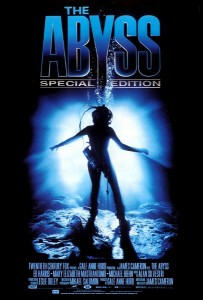 Following the success of pictures like The Terminator (1984) and Aliens (1986), it seemed James Cameron was one of the hottest commodities in Hollywood. With this in mind, Cameron wanted to expand on a short story he wrote as a young man about a group of scientists at the bottom of the ocean into a film. The result was The Abyss, the story of a Navy SEAL team sent to salvage a US submarine lost near a drilling platform close to the Cayman Trough. The rescue is complicated, however, when those at the platform discover extra-terrestrial beings living in the water. Starring Ed Harris, Mary Elizabeth Mastrantonio, and Michael Biehn, The Abyss was one of the most expensive films made for its time that, despite positive reviews and an Oscar win, nonetheless underperformed at box office. A special edition version of the film would be released following the success of Terminator 2: Judgment Day (1991) incorporating elements left out of the original film as well as cleaning up its CGI effects. In a way, The Abyss was a sign of the future CGI would have in film and its special edition was part of a trend of releasing upgraded versions of movies after their initial release with the original Star Wars trilogy a notable example.
Following the success of pictures like The Terminator (1984) and Aliens (1986), it seemed James Cameron was one of the hottest commodities in Hollywood. With this in mind, Cameron wanted to expand on a short story he wrote as a young man about a group of scientists at the bottom of the ocean into a film. The result was The Abyss, the story of a Navy SEAL team sent to salvage a US submarine lost near a drilling platform close to the Cayman Trough. The rescue is complicated, however, when those at the platform discover extra-terrestrial beings living in the water. Starring Ed Harris, Mary Elizabeth Mastrantonio, and Michael Biehn, The Abyss was one of the most expensive films made for its time that, despite positive reviews and an Oscar win, nonetheless underperformed at box office. A special edition version of the film would be released following the success of Terminator 2: Judgment Day (1991) incorporating elements left out of the original film as well as cleaning up its CGI effects. In a way, The Abyss was a sign of the future CGI would have in film and its special edition was part of a trend of releasing upgraded versions of movies after their initial release with the original Star Wars trilogy a notable example.
In the Ninth and Final Part of “The ’80s – Geek Edition,” we’ll examine Comic Books of the 1980s.


